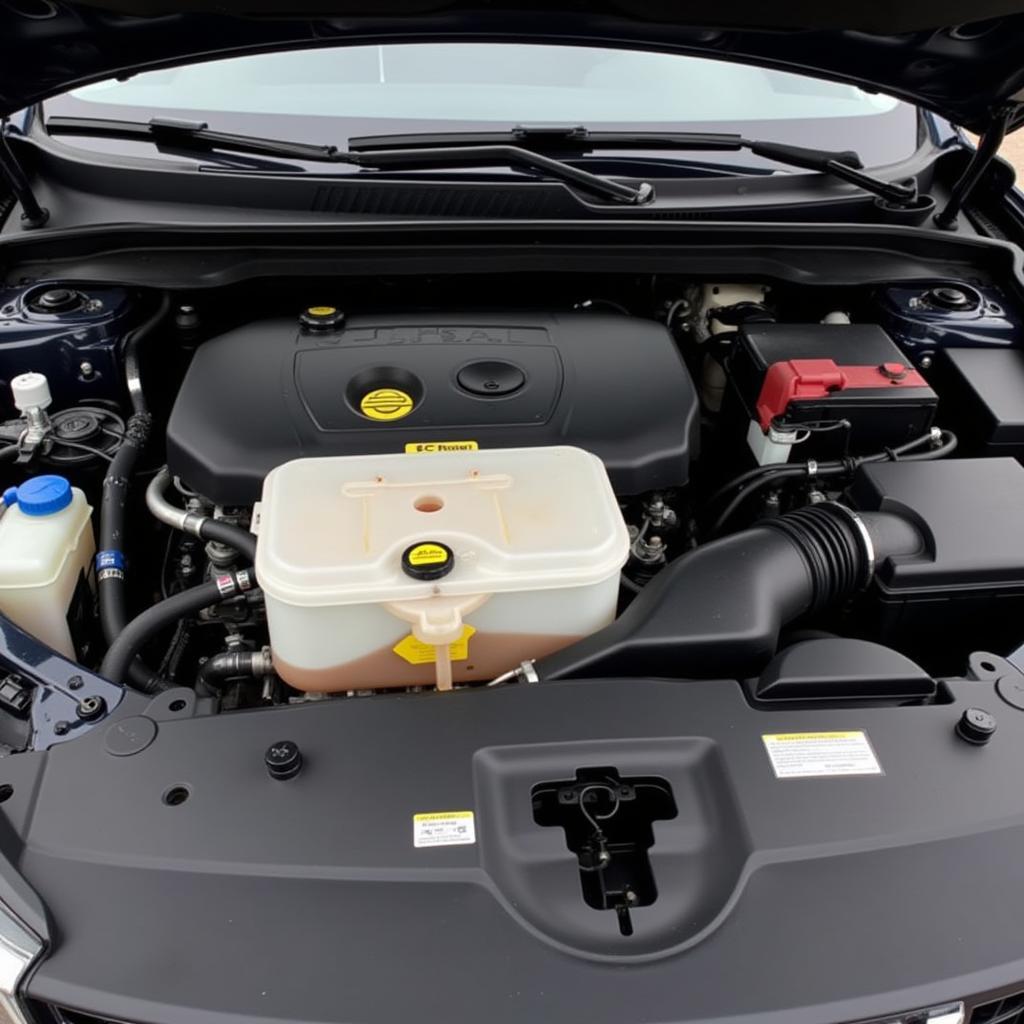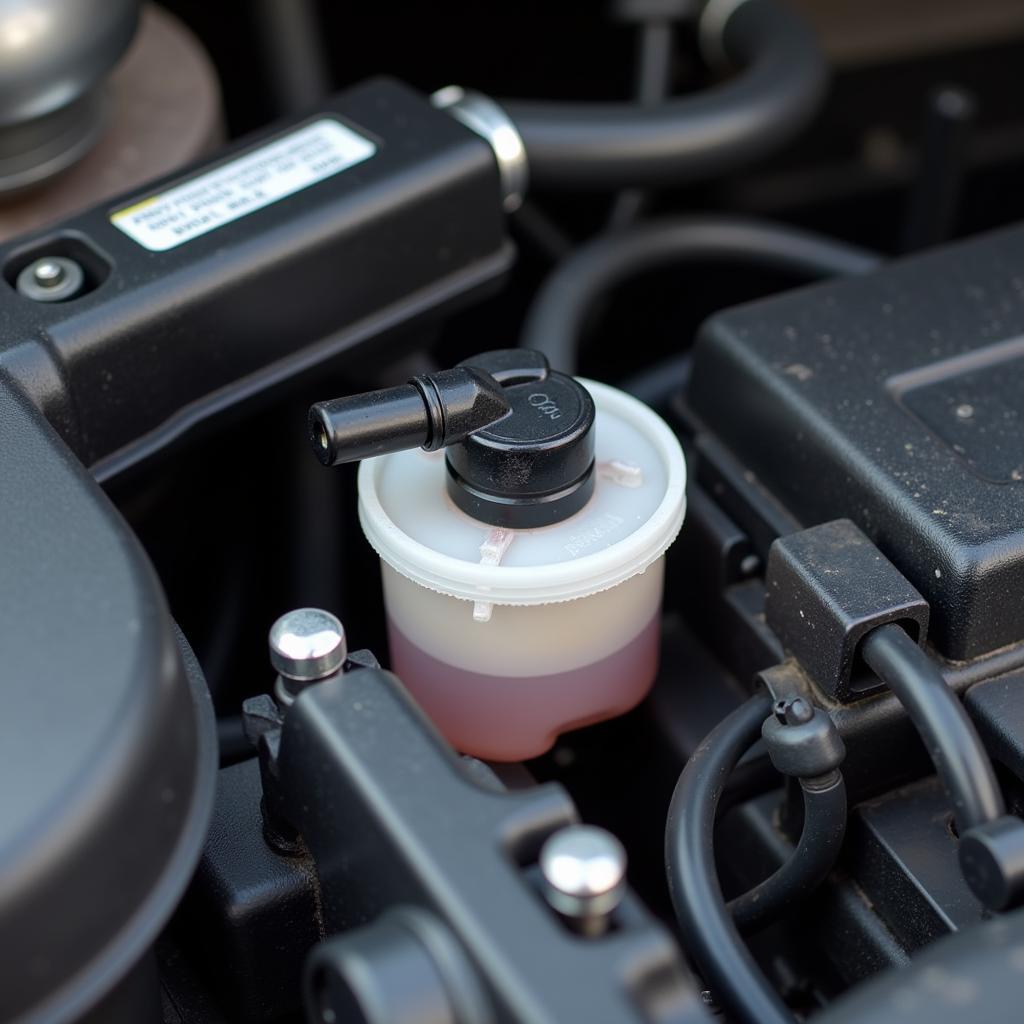The emergency brake warning light on your Nissan Qashqai is a crucial safety feature. When illuminated, it signals a potential issue with your braking system that requires immediate attention. Ignoring this warning could lead to reduced braking performance and increase the risk of an accident. This comprehensive guide will delve into the common causes behind a Nissan Qashqai emergency brake warning light and provide you with potential solutions to get you back on the road safely.
Understanding Your Nissan Qashqai’s Braking System
Before we explore the causes, it’s beneficial to grasp the basics of how your Nissan Qashqai’s braking system functions. The emergency brake, also known as the parking brake or handbrake, is a completely independent mechanical system. When engaged, it uses cables to directly lock the rear wheels, preventing the vehicle from moving.
The warning light itself is triggered in two primary ways:
- Engagement of the Emergency Brake: The most straightforward scenario is that the warning light is simply indicating that your emergency brake is partially or fully engaged.
- Low Brake Fluid Level: Your Qashqai, like all vehicles, relies on hydraulic pressure to operate the main braking system. When the brake fluid level drops too low, it can trigger the emergency brake warning light to signal a potential system failure.
Common Causes of an Illuminated Emergency Brake Warning Light
Now, let’s explore the specific reasons why your Nissan Qashqai’s emergency brake warning light might be on:
1. Engaged Emergency Brake
As mentioned earlier, the most frequent culprit is an engaged or partially engaged parking brake. Before panicking, ensure the brake lever is fully released. Sometimes, even a slight lift of the lever can trigger the warning light.
2. Low Brake Fluid
 Nissan Qashqai Low Brake Fluid Reservoir
Nissan Qashqai Low Brake Fluid Reservoir
Brake fluid is the lifeblood of your car’s braking system. Over time, brake pads wear down, and this wear can result in a lower brake fluid level in the reservoir. If the level falls below the minimum, it can trigger the warning light.
What to do:
- Check the brake fluid level: Locate the brake fluid reservoir under the hood of your Qashqai. The reservoir will have a “MIN” and “MAX” marking.
- Add brake fluid (if needed): If the level is low, carefully add the correct type of brake fluid recommended for your Nissan Qashqai. Consult your owner’s manual for guidance.
Important: If you find yourself adding brake fluid frequently, it’s essential to have your braking system inspected by a qualified mechanic. Consistent fluid loss often indicates a leak, which can severely compromise your braking performance.
3. Faulty Brake Fluid Level Sensor
 Nissan Qashqai Brake Fluid Level Sensor
Nissan Qashqai Brake Fluid Level Sensor
Your Nissan Qashqai is equipped with a sensor in the brake fluid reservoir to monitor the fluid level. Like any electrical component, this sensor can malfunction. A faulty sensor may send incorrect signals, leading to a false warning light.
What to do:
- Diagnosing a faulty sensor often requires specialized tools and knowledge. It’s recommended to consult with a qualified mechanic or Nissan dealership for proper diagnosis and replacement.
4. Worn-out Brake Pads
While worn brake pads themselves don’t directly trigger the emergency brake warning light, they often contribute to low brake fluid levels, as explained earlier. If your brake pads are significantly worn, they can cause the pistons in the brake calipers to extend further, leading to a drop in brake fluid level.
What to do:
- Check your brake pads: Inspect your brake pads for wear. If you see minimal pad material remaining, it’s time for a replacement.
- Consider professional inspection: If you’re unsure about the condition of your brake pads, have them checked by a mechanic.
5. Issues with the Emergency Brake Cable
The emergency brake cable system in your Qashqai can sometimes experience issues:
- Sticking cable: Over time, the emergency brake cable can become corroded or stick, especially if the brake is rarely used. This sticking can cause the emergency brake light to illuminate even if the lever is released.
- Stretched or damaged cable: A stretched or damaged cable can also disrupt the proper functioning of the emergency brake, leading to the warning light.
What to do:
- Inspect the cable: Visually inspect the emergency brake cable for any signs of damage, kinking, or stretching.
- Lubricate the cable: If the cable appears dry or corroded, applying a suitable lubricant can help restore its smooth operation.
6. Electrical Malfunctions
While less common, electrical issues within your Nissan Qashqai can also trigger a false emergency brake warning light. These issues can include:
- Short circuits: A short circuit in the wiring related to the emergency brake system can cause erratic behavior.
- Blown fuse: A blown fuse in the circuit responsible for the emergency brake warning light can also be the culprit.
What to do:
- Check the fuse box: Consult your owner’s manual to locate the fuse box and identify the fuse associated with the emergency brake system.
- Inspect for blown fuses: If a fuse appears blown (usually indicated by a broken wire inside the fuse), replace it with a new fuse of the correct amperage.
Important: For complex electrical issues, it’s crucial to seek the expertise of a qualified auto electrician. Attempting to diagnose and repair electrical problems without proper knowledge can be dangerous.
When to Seek Professional Help
While some causes of an illuminated emergency brake warning light can be addressed with basic troubleshooting, it’s crucial to recognize when professional help is necessary. Here are instances where you should consult a qualified mechanic or your Nissan dealership:
- You’ve checked for the common causes, but the warning light persists.
- You notice a leak in the brake system.
- You hear unusual noises when applying the brakes.
- Your brake pedal feels spongy or goes all the way to the floor.
Conclusion
A glowing emergency brake warning light in your Nissan Qashqai is a serious matter that should never be ignored. By understanding the potential causes and solutions outlined in this guide, you can take appropriate action to ensure your safety and the well-being of your vehicle. Remember, if you’re unsure about any aspect of your braking system, it’s always best to err on the side of caution and consult with a qualified professional. Safe driving!
